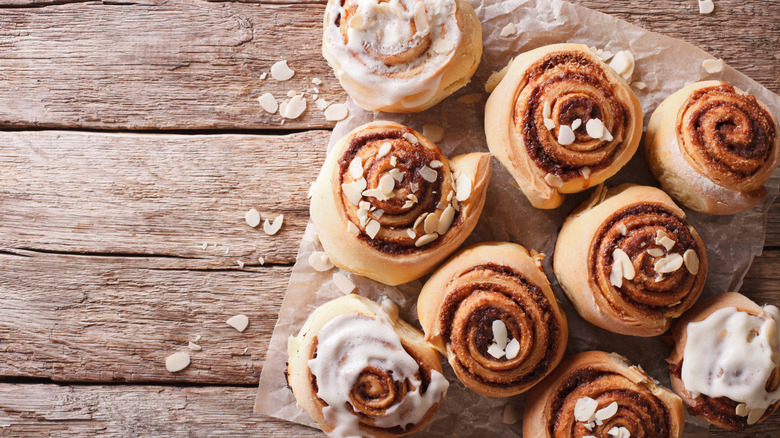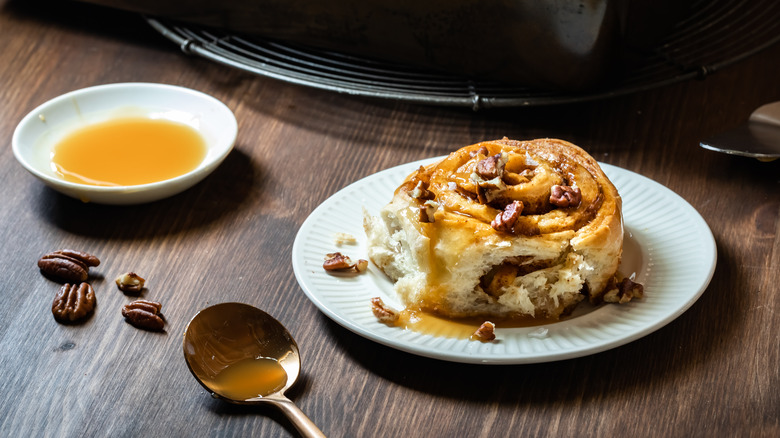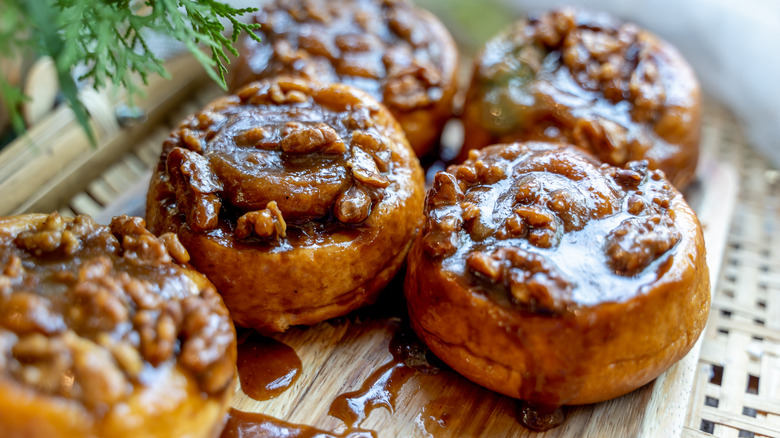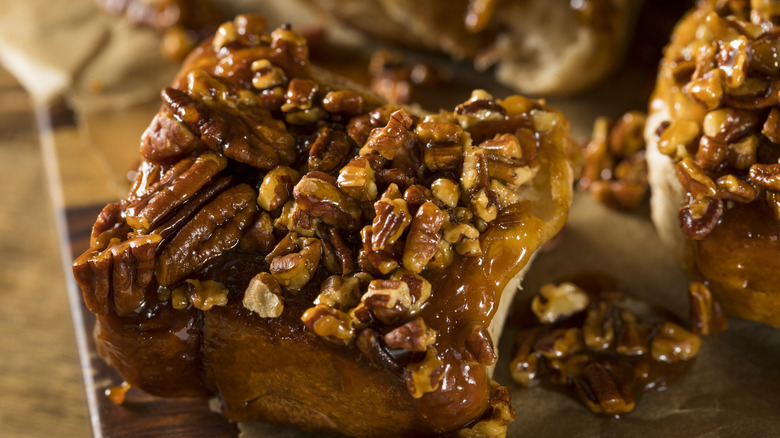The Sweet Differences Between Cinnamon Rolls And Sticky Buns
In the world of sweet breakfast pastries, few treats are as beloved as cinnamon rolls and sticky buns. These delectable swirls of dough, sugar, and spice have captivated our taste buds and warmed our hearts for generations. Despite their popularity, however, you might not know the big differences between these sweet treats, or if there are any standardized differences at all.
Despite their similar shapes and flavors, cinnamon rolls and sticky buns do possess unique characteristics that set them apart. Both pastries feature a cinnamon and sugar filling, but cinnamon rolls typically use a more generous amount, while sticky buns focus more on the layer of caramelized sugar that forms underneath the dough, giving them their "sticky" name.
In addition to this, sticky buns are crowned with nuts and a luscious caramel topping, while cinnamon rolls often don a creamy frosting or glaze. Finally, cinnamon rolls are renowned for their soft, pillowy texture, whereas sticky buns offer a delightful contrast between the tender dough and the crunchy, nut-topped exterior. Beyond these basic traits, these baked goods have even more similarities and differences.
What are cinnamon rolls?
The modern cinnamon roll, as we know it today, is believed to originate from Sweden. In their country of origin, cinnamon rolls are known as "kanelbullar," and they became popular during the 17th century. When European immigrants came to the U.S., cinnamon rolls were introduced to Americans, and are widely known across the country as simple yet irresistible breakfast treats.
Cinnamon rolls are crafted using a rich, buttery dough, sweet granulated sugar, and of course, ground cinnamon. The dough, typically made with flour, sugar, eggs, milk, and yeast, is rolled out into a thin rectangle. Next, a luscious layer of softened butter is spread generously across its surface, followed by a shower of cinnamon and sugar. The dough is then rolled into a tight spiral, creating those iconic layers and swirls. The log of dough is sliced into individual rolls that can be packed into a casserole dish or put on a baking sheet to bake.
Once baked to golden perfection, cinnamon rolls are crowned with a crisp sugar glaze or a velvety frosting. The result is a delectable marriage of warm, tender pastry and a fragrant, sweet filling, perfectly complemented by the rich, smooth icing. It's the kind of breakfast treat that can transport you to a cozy kitchen with every bite. A sticky bun provides a similar level of sticky-sweet comfort, but is made a bit differently.
What are sticky buns?
The sticky bun, which is just as irresistible as a cinnamon bun, can be traced back to Pennsylvania Dutch country, where a fusion of European baking traditions and local ingredients gave rise to this beloved sweet treat. Sticky buns begin with a base of tender, yeasted dough, much like a cinnamon roll. However, what truly distinguishes them is their sticky caramel topping.
The pan used to bake sticky buns is coated with a rich, gooey caramel sauce. This luscious concoction can be made with ingredients like butter, brown sugar, and often pecans or other nuts, creating a deep, toasty sweetness that's downright addictive. This further separates the buns from cinnamon rolls, as the sweet topping on the latter is added after baking.
The dough for sticky buns is rolled out and topped with a mixture of brown sugar, cinnamon, and sometimes raisins or even more nuts. The dough is then carefully rolled into a cylinder and sliced into individual portions. These slices are nestled in the pan on top of the caramel sauce. After baking, the buns are inverted onto a serving platter, revealing their glorious, caramelized tops. The sticky bun experience is a symphony of textures and flavors — the soft, fluffy dough, the rich caramelized exterior, and the sugary filling, all harmonizing in a delectable sweet symphony.
Sticky buns are more likely to use nuts
Both cinnamon rolls and sticky buns can be topped with nuts, but sticky buns are more likely to include nuts in both the filling and topping, while basic cinnamon rolls don't include them. Some of the most popular choices for sticky buns are pecans and walnuts, which add a delightful crunch and nutty richness to every bite. You could also opt to use a variety of other nuts such as almonds or even hazelnuts.
The nuts must be carefully prepared before using in the topping or filling of sticky buns. Most recipes call for chopped nuts for a more even distribution throughout or on top of the dough. Plus, chopped nuts make it easier to cut the buns if you prefer to eat them with a knife and fork. As the buns bake, the nuts on top become roasted to perfection, infusing the pastry with their earthy flavor and providing a delightful contrast to the sweet, sugary caramel.
Cinnamon rolls must contain cinnamon
Cinnamon rolls are undeniably defined by their star spice, cinnamon. It's the aromatic, warm embrace of the spice that makes these rolls the comforting treat we know and love. Obviously, they just wouldn't be cinnamon rolls without cinnamon, but on the other hand, this spice is not a must-use for sticky buns.
Most sticky bun recipes feature cinnamon, but it's not a strict requirement. Sticky buns can contain other fragrant spices like nutmeg, allspice, or even cloves. These spices bring their own unique character to the sticky bun party. Cinnamon rolls, meanwhile, feature cinnamon as the unrivaled star. Recipes may call for small amounts of other spices, but flavors besides cinnamon are hardly a requirement.
Cinnamon rolls are a good choice for an easy recipe, but if you enjoy experimenting with flavors, sticky buns open the door to a world of aromatic possibilities, inviting you to savor a blend of spices in every bite. Not only does this allow for a more complex flavor, but it prevents the buns from becoming too one-note, which is great for a more grown-up treat.
Sticky buns are not iced
Cinnamon rolls are often gloriously crowned with icing. This delectable finishing touch takes the form of either luscious cream cheese frosting or a simple powdered sugar glaze. Cream cheese frosting, with its rich, velvety texture and tangy undertones, complements the warm, cinnamon-spiced rolls perfectly. On the other hand, the powdered sugar glaze, a classic choice, offers a delightful sweetness that blankets the rolls with a sugary coat.
Sticky buns, meanwhile, can be iced, but it's not direly needed. The caramelized mixture of nuts, brown sugar, and butter on top is more than enough. Those with a serious sweet tooth might top off a batch of sticky buns with frosting, but traditional recipes don't feature any toppings beyond the characteristic layer of caramel. On the note of alternative ways to serve these treats, you can also forgo icing on your cinnamon rolls if you prefer a more restrained sweetness. When you whip up these pastries at home, you can customize them to your liking.
Whether you're indulging in the comfort of a cinnamon roll or savoring the rich, caramelized delights of a sticky bun, there's no doubt that both of these pastries hold their own. The next time you're faced with the dilemma of choosing between these two sweet marvels, you'll know the differences between them, but you can't really go wrong with either.





